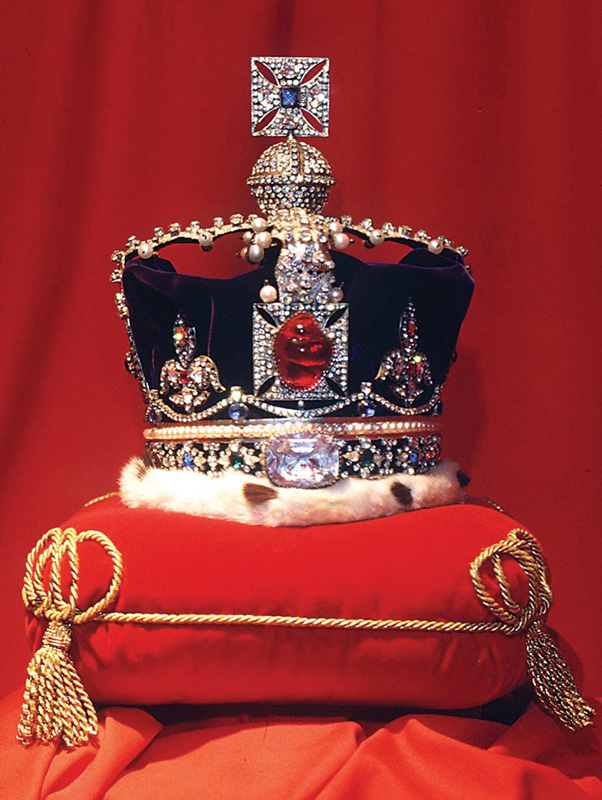
WHAT IT IS Perhaps the ultimate crime caper
WHY YOU WON’T DO IT There is no better guarded treasure on the planet
As you might expect, it has never been very easy to get your hands on the Crown Jewels of the British monarchy, although there have been a few notable attempts over the years. If you’re thinking of giving it a go today, you will find security better than ever – but there are still lessons to be learned from the attempts of the past.
The Crown Jewels of the United Kingdom are estimated to be worth something in the region of £13 billion (US$20 billion). The centrepiece Imperial State Crown (made in 1838 for Queen Victoria and shown opposite) includes the Black Prince’s Ruby, a jewel the size of a hen’s egg given to the famous son of Edward III in 1367, alongside some 2,818 diamonds, 297 pearls and assorted other gems.
It weighs in at a neck-straining 0.9 kilograms (2 lb). The Sceptre with the Cross, meanwhile, houses the Cullinan I diamond (or ‘Great Star of Africa’), a 530-carat beauty cut from the largest diamond ever mined. Or perhaps you prefer the rather less showy 186-carat Koh-i-Noor, the second largest cut diamond in the world, which now sits in the1937 Crown of Queen Elizabeth?
The Crown Jewels have resided at the Tower of London since 1303 – brought to this most secure of royal castles after an attempted theft from their previous home at Westminster Abbey. Since 1994 they have been housed in a specially constructed Jewel House at Waterloo Barracks, where they can be viewed by 2,500 people per hour. They lie on French velvet, behind 5-centimetre-thick (2-in) reinforced glass, and even if you breached the casing, your chances of eluding the entire Tower Guard and the Yeomen Warders are remote. But things weren’t always this secure, and the most famous attempted theft of all, carried out by the enticingly named Colonel Blood, came perilously close to success.
Anglo-Irish soldier Thomas Blood conceived his audacious scheme in 1671, at a time when the jewels were open for inspection in the Martin Tower at the Tower of London by paying the custodian. In late spring, Blood visited the Tower disguised as a parson and in the company of a female accomplice who pretended to be his wife. While viewing the jewels, the ‘wife’ feigned stomach cramps, at which point the elderly Master of the Jewel House, one Talbot Edwards, hurried off to get her a tonic. Mrs Edwards took pity on Mrs Blood and invited her to recover in their apartment. Over the following weeks, an apparent friendship blossomed between the two couples. Eventually, as was the way of things back then, Blood even suggested that his nephew might be a fitting husband for the Edwards’s daughter.
On 9 May, Blood arranged for another viewing of the Crown Jewels, this time in the company of his ‘nephew’ and two other companions. They carried canes containing blades and assorted other weapons. While one of the thieves stood guard, the others attacked Edwards, throwing a cloak over him and beating and stabbing him, before tying him up and gagging him. The metal grille that protected the jewels was then removed and the men made a grab for whatever they could carry, mutilating the regalia where necessary in order to conceal it upon their persons.
As luck would have it, Edwards’s son stumbled upon the raid just as his father managed to free himself from his bindings. They raised the alarm, and Blood and his men fled with several warders in pursuit. Blood was soon caught and the stolen finery retrieved. Bound in chains, he was hauled before the king but, to general bemusement, secured himself not only a royal pardon but a tidy estate in Ireland to boot. It has been suggested that the king was won over by Blood’s shameless bravado, but anyone attempting a similar ruse today can expect rather less lenient treatment.
IMPENETRABLE FORTRESS A view across the substantial walls of the Tower of London towards the central White Tower, built on the orders of William the Conqueror in the late 11th century. Today the British Crown Jewels are kept in the Jewel House at Waterloo Barracks, just opposite the White Tower and under constant guard.